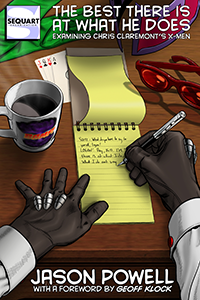Call me crazy, but I want to write about Sovereign Seven.
Why? Well, because for a short time, Chris Claremont wrote for DC Comics. And no one seems to care.
Besides Stan Lee, no one creator has been as synonymous with the Marvel brand as Chris Claremont. In 1991, he shocked X-Men readers by leaving the title and characters he had spent the better part of two decades on. If any one person could lay claim to having made the X-Men franchise what it was in the early 90s (and what it still is today), it would be Claremont. But as the franchise grew, Claremont found himself exercising less and less control over the direction of the characters within his book. In the midst of an explosion of X-related titles, Claremont left Marvel due to the oft-cited “creative differences.” In a November ’95 interview with Wizard Magazine he said:
“But the problem is that you are not working in a vacuum. This is the frustration of work-for-hire. You have to allow for that fact – hard as it may be to accept – somebody is going to come in at some point and say, look, we need this character in such-and-such-book or you can’t do this with these characters because of the impact it will have on these titles in the line.”
Part of Claremont’s reaction was to create Sovereign Seven.
Yet as an astute reader of comics, you might be asking, what exactly is Sovereign Seven?
S7, for those of us who remember it, was a creator-owned comic smack-dab in the middle of the DC Universe, written and drawn by Chris Claremont and Dwayne Turner. The comic itself was marketed as an introduction to DC Comics. Not only were the Sovereign Seven strangers in a strange land, but Claremont and many of his readers would be as well.
So why write a column about a critically-unacclaimed series that lasted 36 issues and hasn’t been mentioned by a single character in the DCU since Claremont returned to his old stomping grounds at Marvel?
Because it’s Chris Claremont. If Stan Lee and Jack Kirby had fathered the X-Men, Claremont was the one who guided it from infancy to adulthood. By the time Claremont’s 17-year run ended, X-Men was one the best selling comics on the block and had spawned a whole host of best-selling X-related titles.
And because he failed miserably. For some reason, Sovereign Seven just didn’t click with Claremont fans or faithful DC heads. Why didn’t it live up to the standards he had set on X-Men and The New Mutants? Why couldn’t the marketplace support both the Claremont-less X-Men and his own creator-owned book? Had Claremont’s X-Men eclipsed Claremont the writer?
You have to remember a couple of things about the industry circa 1995. The bottom of the speculator market had already fallen out, not long after Claremont and the Image founders left Marvel to do their own things. Not only were creators like Claremont leaving long-established positions due to editorial disputes over the cross-pollination of popular characters, hundreds of thousands of readers were leaving companies that catered to collectors and forced fans to buy multiple titles to follow a single storyline in their favorite book.
Along with X-Men, the best selling titles were Gen 13, Spawn and anything concerning the ubiquitous bad girl craze. This was about the same time that Mark Waid and Ron Garney’s first run on Captain America was nixed by the-powers-that-be because it wasn’t sexy enough, paving the way for a more buzz-worthy Rob Liefeld and Heroes Reborn to take over the reigns of the Star-Spangled Avenger. In other words, it almost didn’t matter if you were spinning pure gold. Image and T&A were the only ways to go.
To top it all off, there wasn’t one DC Comic in the top 20. Superman couldn’t find a haircut. The JLA were still a joke. And the Long Halloween hadn’t yet begun.
This was the DCU Chris Claremont wanted his characters to be a part of?
No doubt Claremont had something to prove. Instead of publishing through Homage or Legends, Claremont wanted Sovereign Seven to be part of an established universe – the DC universe no less. S7 was ground-breaking in the fact that it was the first creator-owned comic to exist in that universe. DC was struggling, and if it could bring new readers into the fold, Claremont would likely have found his way onto Superman and JLA in no time.
I was one of those new readers, picking up Sovereign Seven sometime during the last few months of 1995. But being all of 14-years-old, and a Marvel zombie at that, DC had never really been on my radar, except where Chris Claremont was concerned.
Yet I didn’t stick with it. I was too concerned with the exploits of Cable, the Hulk and Wolverine to take note. Mostly, I was just an idiot loyalist at the time, spending untold amounts of cash on crappy miniseries featuring anyone who appeared within the pages of X-Men. But by the time Claremont found himself back on the Marvel payroll, I had had enough. My last issue of the X-universe was Wolverine #125, written by Claremont, and one of the most disappointing Canucklehead stories I had ever read. Peter David’s departure from the Hulk not long after was the last straw.
I was gone.
But…
Eight years later I still want to know, what happened to Sovereign Seven? Why didn’t the book make it? Why doesn’t anyone seem to remember these characters? And, most importantly, where does it rank among the annals of Chris Claremont’s collected works?
This series will attempt to answer these questions and give an issue by issue account of Chris Claremont’s foray into the hallowed halls of the DC Universe.
Let’s get to it.
























































